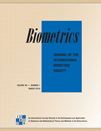Estimating Disease Prevalence Using Relatives of Case and Control Probands
Abstract
Summary We introduce a method of estimating disease prevalence from case–control family study data. Case–control family studies are performed to investigate the familial aggregation of disease; families are sampled via either a case or a control proband, and the resulting data contain information on disease status and covariates for the probands and their relatives. Here, we introduce estimators for overall prevalence and for covariate-stratum-specific (e.g., sex-specific) prevalence. These estimators combine the proportion of affected relatives of control probands with the proportion of affected relatives of case probands and are designed to yield approximately unbiased estimates of their population counterparts under certain commonly made assumptions. We also introduce corresponding confidence intervals designed to have good coverage properties even for small prevalences. Next, we describe simulation experiments where our estimators and intervals were applied to case–control family data sampled from fictional populations with various levels of familial aggregation. At all aggregation levels, the resulting estimates varied closely and symmetrically around their population counterparts, and the resulting intervals had good coverage properties, even for small sample sizes. Finally, we discuss the assumptions required for our estimators to be approximately unbiased, highlighting situations where an alternative estimator based only on relatives of control probands may perform better.




